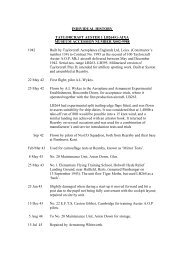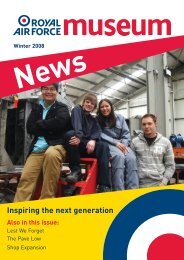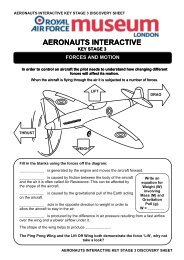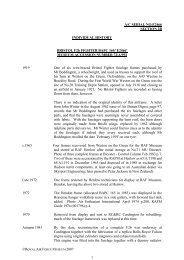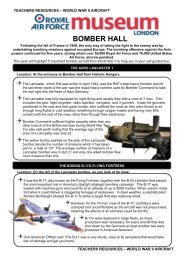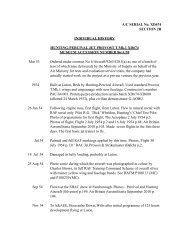Second World War Handling Collection - RAF Museum
Second World War Handling Collection - RAF Museum
Second World War Handling Collection - RAF Museum
Create successful ePaper yourself
Turn your PDF publications into a flip-book with our unique Google optimized e-Paper software.
Teacher Resource Pack:<br />
<strong>Second</strong> <strong>World</strong> <strong>War</strong> <strong>Handling</strong> <strong>Collection</strong><br />
<strong>Second</strong> <strong>World</strong> <strong>War</strong> <strong>Handling</strong> <strong>Collection</strong><br />
Educational support materials for groups participating in this<br />
activity<br />
This pack contains information designed to support teachers<br />
whose classes are visiting the <strong>RAF</strong> <strong>Museum</strong> and participating in<br />
the <strong>Handling</strong> <strong>Collection</strong> Activity. It is intended to provide<br />
information and suggestions for class lessons before and after the<br />
activity. All the photos and diagrams are available for reasonable<br />
reproduction to help with teaching.<br />
Contents<br />
Page<br />
1. Educational Background 2<br />
2. Activities for the Classroom 8<br />
Pictures<br />
1. Images taken in Britain 6<br />
2. Images taken in Occupied Europe 7<br />
Additional Resources<br />
1. <strong>War</strong> Poetry 10<br />
Additional images from the <strong>RAF</strong> <strong>Museum</strong>’s collections can be<br />
found online at http://navigator.rafmuseum.org/<br />
1
Teacher Resource Pack:<br />
<strong>Second</strong> <strong>World</strong> <strong>War</strong> <strong>Handling</strong> <strong>Collection</strong><br />
<strong>Second</strong> <strong>World</strong> <strong>War</strong> <strong>Handling</strong> <strong>Collection</strong><br />
Educational Background to the <strong>Handling</strong> <strong>Collection</strong> Activity<br />
Links to the Curriculum<br />
The <strong>Second</strong> <strong>World</strong> <strong>War</strong> <strong>Handling</strong> <strong>Collection</strong> Activity relates to a number of key<br />
areas of the National Curriculum. This section of the teacher resource pack<br />
discusses the historical and social factors which provide a background to the<br />
activity.<br />
The <strong>Second</strong> <strong>World</strong> <strong>War</strong><br />
The <strong>Second</strong> <strong>World</strong> <strong>War</strong> for Britain started in 1939, when Nazi Germany<br />
invaded Poland. There were two opposing forces comprised of a variety of<br />
countries. The Allied forces included Britain, Poland, France, China, Russia,<br />
India, Yugoslavia, United States, Lithuania, Czechoslovakia, Greece, Burma,<br />
Australia, New Zealand, Canada, Norway and Latvia. The Axis forces<br />
included Germany, Japan, Romania, Hungary, Bulgaria and Italy. The<br />
members of both the Axis and Allied forces changed throughout the war some<br />
countries joining later or leaving earlier.<br />
Axis forces initially appeared to be winning the war as they successfully<br />
occupied most of Europe, however this stretched their resources thinly and<br />
attempts to occupy further territory were successfully resisted, for example the<br />
Soviet Union was not defeated. Many of the occupied countries such as<br />
France and Belgium also resisted the Axis forces by sabotaging Axis bases<br />
and supply lines or helping allied air crew or prisoners of war to escape or<br />
evade capture.<br />
The failure of the Axis air forces’ campaign against the Royal Air Force during<br />
the Battle of Britain prevented the invasion of Britain and provided the Allies<br />
with a suitable location to assemble forces for the D-Day landings. D-Day (6 th<br />
June 1944) was to result in the liberation of France from the Axis forces. This<br />
was the beginning of the end of the <strong>Second</strong> <strong>World</strong> <strong>War</strong>. The war finally ended<br />
in 1945 when Japan, the last surviving member of the Axis forces<br />
surrendered.<br />
2
Teacher Resource Pack:<br />
<strong>Second</strong> <strong>World</strong> <strong>War</strong> <strong>Handling</strong> <strong>Collection</strong><br />
The Blitz<br />
Although the <strong>Second</strong> <strong>World</strong> <strong>War</strong> did not begin until 1939, Air Raid Precautions<br />
began as early as 1938. The development of aircraft technology had led to the<br />
increasing threat of air assault and Britain began to take measures to combat<br />
possible attacks. Britain began to clear hospitals ready for bomb victims, millions<br />
of cardboard coffins were made, 40 million gas masks were given out and people<br />
volunteered for the ARP (Air Raid Precautions) service.<br />
It was not until the summer of 1940 that German night bombing raids on Britain<br />
started and the Blitz began. The first major daylight raid on London occurred on<br />
7 th September 1940. 350 bombing aircraft and 650 fighting aircraft were used to<br />
attack important areas such as London’s docks and oil refineries, in this raid. The<br />
bombing lasted all through the night until 8 th September, killing at least 400<br />
people and injuring 1600 others. The Blitz continued until May 1941 when<br />
Germany turned her attention to the Soviet Union.<br />
Remember that it was not just British cities that were attacked during bombing<br />
raids. The Royal Air Force (<strong>RAF</strong>) attacked German cities including Berlin,<br />
damaging buildings, destroying schools and killing citizens.<br />
Air Raid Shelters<br />
There were two common types of air raid protection, the Anderson Shelter and the<br />
Morrison Shelter. The Anderson Shelter was built outside in the garden. It was<br />
made out of corrugated iron and was half buried in the garden and covered with 40<br />
- 50 cm of soil. The Morrison Shelter was used in the home. It was a strong metal<br />
mesh box which people could hide in. They would often keep it in the living room<br />
where it could be used as a table when it wasn’t being used as a shelter.<br />
Rationing<br />
Before the <strong>Second</strong> <strong>World</strong> <strong>War</strong>, Britain imported about 55 million tons of food a<br />
year from other countries. After the war was declared in September 1939, the<br />
British Government was not able to import the same amount of food from abroad<br />
as German submarines started sinking British merchant ships. There was a<br />
worry that this would lead to shortages of food in the shops so the Government<br />
decided to introduce a system of rationing.<br />
Everybody was issued with ration books. Ration books contained coupons that<br />
shopkeepers clipped out of the books when people bought food and other items.<br />
This controlled the amount of an item people were able to buy. Sometimes even<br />
if you had the correct coupons, you would not be able to buy everything you<br />
wanted because the shop would have run out. This led to huge queues outside<br />
shops when items such as sugar were in stock.<br />
3
Teacher Resource Pack:<br />
<strong>Second</strong> <strong>World</strong> <strong>War</strong> <strong>Handling</strong> <strong>Collection</strong><br />
The Blackout<br />
Britain was blacked out on 1st September 1939, two days before the outbreak of war.<br />
Everyone had to cover their windows and doors at night with heavy blackout curtains,<br />
cardboard or paint to prevent any glimmer of light from escaping and aiding enemy<br />
aircraft during their bombing raids. This is because the bright lights of the city would<br />
make any city or town an easy target for bombs.<br />
Street lights were switched off or dimmed and shielded to deflect their light<br />
downwards. Traffic lights and vehicle headlights were fitted with slotted covers to<br />
deflect their beam down to the ground.<br />
The number of road accidents increased because of the reduced street lighting. A<br />
number of measures were taken to try and prevent these accidents:<br />
White stripes were painted on the roads and on lamp posts.<br />
People were encouraged to walk facing the traffic.<br />
Men were advised to leave their shirt tails hanging out so that they could be<br />
seen by cars with dimmed headlamps.<br />
People were also injured in accidents during the blackout because they could not see<br />
in the darkness. Many people were hurt tripping up, falling down stairs or bumping<br />
into things.<br />
Gas Attacks and Gas Masks<br />
Gas was a very nasty weapon that could be dropped from aeroplanes. There were<br />
several types of gas and they were all poisonous. Many soldiers had been gassed<br />
during the First <strong>World</strong> <strong>War</strong>. It was feared that if gas was dropped on Britain it would kill<br />
many men, women and children.<br />
The Government decided that it would be a good idea to issue everyone with their own<br />
gas mask. 40 million gas masks were given out. These masks were made of rubber<br />
and were easy to put on but had to fit tightly around the face to prevent gas from<br />
getting in. They were not very comfortable and would quickly steam up inside. There<br />
were special ones for children, made of red rubber. They were made to look like<br />
Donald Duck or Mickey Mouse; even so, children did not like them very much as they<br />
were uncomfortable.<br />
Poisonous gas was detected by painting the tops of pillar boxes yellow with a special<br />
kind of paint that would change colour if there was any gas in the air. This would act as<br />
a warning to everybody in the street. Gas masks had to be carried at all times in their<br />
cardboard case. Some cinemas would not let a person in without their gas mask.<br />
However, the Germans did not drop any poisonous gas and soon people tired of<br />
carrying their gas masks.<br />
4
Teacher Resource Pack:<br />
<strong>Second</strong> <strong>World</strong> <strong>War</strong> <strong>Handling</strong> <strong>Collection</strong><br />
Evacuation<br />
It soon became apparent that some parts of the country were going to be<br />
attacked more than others, mainly cities such as London and Coventry. Plans<br />
were made for children living in these areas to be sent to safer parts of the<br />
country (and sometimes even other countries). This process was known as<br />
evacuation. Children below school age had to stay with their mothers whether<br />
they were evacuated or not, but those children old enough to attend school<br />
were strongly advised to be sent away. Evacuation was not compulsory.<br />
The families that took in children from the evacuated towns and cities were<br />
known as foster families. When the evacuated children arrived they would<br />
have a health check and then foster parents would collect them to take them<br />
to their new homes. This would be the first time that many children had been<br />
to the countryside. The children would write back home to let their parents<br />
know that they were alright and to tell them their news. Foster parents would<br />
be paid 8s 6d (about 43p) per week for every child that they looked after.<br />
The Royal Air Force (<strong>RAF</strong>)<br />
The Royal Air Force was formed in 1918 from the Royal Flying Corps and the<br />
Royal Naval Air Service. After the First <strong>World</strong> <strong>War</strong>, the number of personnel<br />
and aircraft in the <strong>RAF</strong> was drastically reduced, leaving it underpowered when<br />
compared to other European air forces such as the German Luftwaffe. It was<br />
not until just before Britain entered the <strong>Second</strong> <strong>World</strong> <strong>War</strong> that the <strong>RAF</strong> began<br />
to build more aircraft and employ more personnel. The <strong>Second</strong> <strong>World</strong> <strong>War</strong><br />
was a time of rapid expansion for the <strong>RAF</strong> but even with this expansion they<br />
were still poorly equipped to deal with the Luftwaffe attacks during the Battle<br />
of Britain. Do not miss the ‘Our Finest Hour’ show in the Battle of Britain Hall,<br />
for more information about the Battle of Britain. Despite overwhelming odds<br />
the <strong>RAF</strong> were able to hold off the Luftwaffe until there was no possible chance<br />
of a German invasion.<br />
The <strong>RAF</strong> also mounted a strategic bombing campaign against Germany.<br />
There were a number of daylight and night time raids on various military<br />
targets, attacks on civilian targets began after bombs were dropped on<br />
London. This first bombing of London is often thought to have been<br />
accidental. The bombing campaign cased increasing damage as technology<br />
developed and more aircraft were built. Famous bombing raids such as the<br />
Dambusters’ Raid were of great strategic importance and served to boost<br />
British morale. Visit the Bomber Command Hall to learn more about the<br />
Dambusters’ Raid.<br />
Today the <strong>RAF</strong> is still going strong, playing an important part in relief missions<br />
and wars around the world. Visit the Milestones of Flight Hall to see some of<br />
the <strong>RAF</strong> newest aircraft.<br />
5
Teacher Resource Pack:<br />
<strong>Second</strong> <strong>World</strong> <strong>War</strong> <strong>Handling</strong> <strong>Collection</strong><br />
Result of a German<br />
flying bomb attack on a<br />
row of semi detached<br />
houses.<br />
Senior <strong>RAF</strong> personnel at<br />
<strong>RAF</strong> Digby, 1945 shaking<br />
hands with King George VI.<br />
King George VI is wearing<br />
the Marshal of the <strong>RAF</strong><br />
uniform.<br />
6
Teacher Resource Pack:<br />
<strong>Second</strong> <strong>World</strong> <strong>War</strong> <strong>Handling</strong> <strong>Collection</strong><br />
Result of an <strong>RAF</strong><br />
incendiary bomb attack in<br />
Germany. The light from<br />
the fires started by the<br />
incendiary bombs creates a<br />
target for aircraft carrying<br />
high explosive bombs.<br />
Prisoners of <strong>War</strong>,<br />
watching aircraft activity<br />
above them in Germany,<br />
1943.<br />
7
Teacher Resource Pack:<br />
<strong>Second</strong> <strong>World</strong> <strong>War</strong> <strong>Handling</strong> <strong>Collection</strong><br />
<strong>Second</strong> <strong>World</strong> <strong>War</strong> <strong>Handling</strong> <strong>Collection</strong><br />
Activities for the classroom<br />
Links to the Curriculum<br />
The <strong>Second</strong> <strong>World</strong> <strong>War</strong> <strong>Handling</strong> <strong>Collection</strong> relates to a number of key areas<br />
of the National Curriculum. This teacher resource pack is intended to provide<br />
some suggestions for classroom activities for a variety of subjects.<br />
History Activities<br />
Activity: Think about what life would have been like for people serving in the<br />
<strong>RAF</strong> during the <strong>Second</strong> <strong>World</strong> <strong>War</strong>. What sort of jobs did they do What<br />
would they have experienced How did the feel about the families they left<br />
behind Do you think <strong>RAF</strong> personnel experience the same things today<br />
Activity: Imagine you work for MI9 during the <strong>Second</strong> <strong>World</strong> <strong>War</strong>. Your job is<br />
to design escape and evasion aids for <strong>RAF</strong> aircrew, such as the button<br />
compass or the escape boot. What ideas can you think of How would they<br />
work<br />
Research: Find out what life was like during the <strong>Second</strong> <strong>World</strong> <strong>War</strong>. Try<br />
talking to your elderly relatives and their friends, what happened to them<br />
during the war<br />
Research: What happened in your local area during the <strong>Second</strong> <strong>World</strong> <strong>War</strong><br />
Were there any bombing raids Can you find any buildings that have<br />
survived the <strong>Second</strong> <strong>World</strong> <strong>War</strong> Try talking to some of your community’s<br />
older people; do they have any memories of the <strong>Second</strong> <strong>World</strong> <strong>War</strong><br />
Activity: Look at the jobs people could do on the Home Front during the<br />
<strong>Second</strong> <strong>World</strong> <strong>War</strong> e.g. Fire Watching, Women’s Land Army, Air Raid<br />
<strong>War</strong>den, Women’s Voluntary Service or the Home Guard. Would you like to<br />
do any of these jobs Why<br />
8
Teacher Resource Pack:<br />
<strong>Second</strong> <strong>World</strong> <strong>War</strong> <strong>Handling</strong> <strong>Collection</strong><br />
English Activities<br />
Letter Writing: Write a letter to the person who led your activity or to the<br />
Education Team at the <strong>RAF</strong> <strong>Museum</strong>, to tell them how you felt about your trip<br />
and what you learnt.<br />
Creative Writing: Write a first person account of what it feels like to live<br />
during the <strong>Second</strong> <strong>World</strong> <strong>War</strong>. Why not write about how you felt during a<br />
recent air raid or how it feels to have a father fighting with the <strong>RAF</strong>.<br />
Role Play: Act out a typical wartime scene in small groups. Themes could<br />
include building an Anderson Shelter, sheltering from a bombing raid,<br />
travelling during the blackout or a father going or coming home from an <strong>RAF</strong><br />
posting.<br />
Poetry: Look at some poems written by people during the <strong>Second</strong> <strong>World</strong> <strong>War</strong><br />
(some examples are included in the additional resources). What emotions<br />
have the authors tried to express in them How do you feel about the <strong>Second</strong><br />
<strong>World</strong> <strong>War</strong> Try writing your own poem about it.<br />
Art Activities<br />
Activity: Draw or paint a picture showing the damage done in a bombing<br />
raid. Try to convey how you feel about air raids.<br />
Science Activities<br />
Activity: Look at how aircraft fly. What are the forces involved Try<br />
designing a paper aeroplane.<br />
Activity: Look at different materials <strong>RAF</strong> uniforms could be made from.<br />
What properties do they need to have Should they be warm or cool to wear<br />
Does this depend on where the <strong>RAF</strong> personnel are based<br />
Activity: Look at how incendiary bombs work. How does burning affect the<br />
materials in trees and houses Can these changes be reversed<br />
Activity: Look at the Blackout. Why were some materials used to block<br />
lights from windows instead of others<br />
Activity: Design your own air raid shelter. What materials will you use to<br />
build it Think about what properties the shelter needs to have, strong or<br />
weak, gas proof or not<br />
9
Teacher Resource Pack:<br />
<strong>Second</strong> <strong>World</strong> <strong>War</strong> <strong>Handling</strong> <strong>Collection</strong><br />
<strong>Second</strong> <strong>World</strong> <strong>War</strong> <strong>Handling</strong> <strong>Collection</strong><br />
Additional Resources<br />
WAR POETRY<br />
Airmen<br />
The Airman has nothing to say about this.<br />
The moon is rising and she is not his,<br />
Or wings are caking with malignant ice.<br />
Distant the point where different language speaks.<br />
The hours are minutes and the years are weeks.<br />
The slow gulls wander; and the tracer streaks.<br />
Has nothing to say, and this is done.<br />
At night the long youth of the flaring gun;<br />
Against the great raiders, the great sun.<br />
Returning now the dawn lets him be safe:<br />
No one has really asked him for his life,<br />
Eating eggs and bacon with a fork and knife.<br />
Brian Allwood 1920 - 1944 (<strong>RAF</strong> Airman)<br />
Lost<br />
They went down, burning, somewhere over Brest,<br />
and Spitfires levelled off to take revenge.<br />
The Hampdens bombed, wheeled went back into the west.<br />
Below them, the uprising sea was stark and strange.<br />
………This is the way they went, early in September,<br />
Shot from the deep sky while others turned.<br />
They fell, and are a sadness we remember<br />
each time we count those crashed, those not returned.<br />
Herbert Corby 1911 – Present (<strong>RAF</strong> Corporal)<br />
10
Teacher Resource Pack:<br />
<strong>Second</strong> <strong>World</strong> <strong>War</strong> <strong>Handling</strong> <strong>Collection</strong><br />
Parachute Descent<br />
Snap back the canopy,<br />
Pull out the oxygen tube,<br />
Flick the harness pin,<br />
And slap out into the air,<br />
Clear of the machine.<br />
Did you ever dream when you were young<br />
Of floating through the air, hung<br />
Between the clouds and the gay<br />
Be- blossomed land<br />
Did you ever stand and say,<br />
“To sit and think and be alone<br />
In the middle of the sky<br />
Is my one most perfect wish”<br />
That was a fore-knowing;<br />
That you knew some day<br />
To satiate an inward crave<br />
You must play with the wave<br />
Of a cloud. And shout aloud<br />
In the clean air,<br />
The untouched-worldly-things-and-mean air,<br />
With exhilarated living.<br />
You knew that you must float<br />
From the sun above the clouds<br />
To the gloom beneath, of a world<br />
Of rarefied splendour to one<br />
Of cheapened dirt, close-knit<br />
In its effort to encompass man<br />
In death.<br />
David Bourne 1921 – 1941 (<strong>RAF</strong> Pilot Officer)<br />
11



